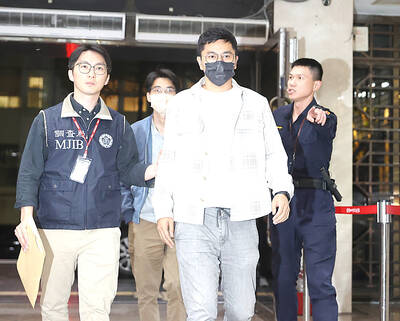A new “carrier killer” missile that has become a symbol of China’s rising military might will not force the US Navy to change the way it operates in the Pacific, a senior Navy commander said.
Defense analysts say the Dong Feng 21D missile could upend the balance of power in Asia, where US aircraft carrier battle groups have ruled the waves since the end of World War II.
However, Vice Admiral Scott van Buskirk, commander of the US 7th Fleet, said that the Navy does not see the much-feared weapon as creating any insurmountable vulnerability for the US carriers — the Navy’s crown jewels.
“It’s not the Achilles heel of our aircraft carriers or our Navy — it is one weapons system, one technology that is out there,” Van Buskirk said in an interview this week on the bridge of the USS George Washington, the only carrier that is home-based in the western Pacific.
The DF-21D is unique in that it is believed capable of hitting a powerfully defended moving target — like the USS George Washington — with pinpoint precision. That objective is so complex that the Soviets gave up on a similar project.
The missile would penetrate defenses because its speed from launch would not allow enough time for carriers or other large ships to complete countermeasures.
That could seriously weaken Washington’s ability to intervene in any potential conflict over Taiwan or North Korea, as well as deny US ships safe access to international waters near China’s long coastline.
Van Buskirk, whose fleet is responsible for most of the Pacific and Indian oceans, with 60-70 ships and 40,000 sailors and Marines under its command, said the capabilities of the Chinese missile are as yet unproven. However, he acknowledged it does raise special concerns.
“Any new capability is something that we try to monitor,” he said.
“If there wasn’t this to point to as a game changer, there would be something else,” he said. “That term has been bandied about for many things. I think it really depends on how you define the game, whether it really changes it or not. It’s a very specific scenario for a very specific capability — some things can be very impactful.”
The development of the missile comes as China is increasingly venturing further out to sea and is becoming more assertive around its coastline and in disputes over territory.
Late last year, China and Japan were locked in a heated diplomatic row over several islands both claim in the East China Sea, an area regularly patrolled by US Navy vessels. A flotilla of 10 Chinese warships, including advanced submarines and destroyers, passed through the Miyako Strait last April in the biggest transit of its kind to date.
Experts saw it as an attempt by China to test Japan and the US and demonstrate its open water capabilities.
Van Buskirk said the US Navy has no intention of altering its mission because of the new threat and will continue to operate in the seas around Japan, South Korea, the Philippines and anywhere else it deems necessary.
“We won’t change these operations because of this specific technology that might be out there, but we will carefully monitor and adapt to it,” he said.
The faster-than-expected development of the missile has set off alarm bells in Washington.
In December, Admiral Robert Willard, the head of the US Pacific Command, told Japan’s Asahi Shimbun he believed the missile program had achieved “initial operational capability,” meaning a workable design had been settled on and was being further developed.
At its most capable, the DF-21D could be launched from land with enough accuracy to penetrate the defenses of even the most advanced moving aircraft carrier at a distance of more than 1,500km.
To allay regional security fears, van Buskirk said, China needs to be more forthcoming about its intentions.

Seventy percent of middle and elementary schools now conduct English classes entirely in English, the Ministry of Education said, as it encourages schools nationwide to adopt this practice Minister of Education (MOE) Cheng Ying-yao (鄭英耀) is scheduled to present a report on the government’s bilingual education policy to the Legislative Yuan’s Education and Culture Committee today. The report would outline strategies aimed at expanding access to education, reducing regional disparities and improving talent cultivation. Implementation of bilingual education policies has varied across local governments, occasionally drawing public criticism. For example, some schools have required teachers of non-English subjects to pass English proficiency

‘FORM OF PROTEST’: The German Institute Taipei said it was ‘shocked’ to see Nazi symbolism used in connection with political aims as it condemned the incident Sung Chien-liang (宋建樑), who led efforts to recall Democratic Progressive Party (DPP) Legislator Lee Kun-cheng (李坤城), was released on bail of NT$80,000 yesterday amid an outcry over a Nazi armband he wore to questioning the night before. Sung arrived at the New Taipei City District Prosecutors’ Office for questioning in a recall petition forgery case on Tuesday night wearing a red armband bearing a swastika, carrying a copy of Adolf Hitler’s Mein Kampf and giving a Nazi salute. Sung left the building at 1:15am without the armband and apparently covering the book with a coat. This is a serious international scandal and Chinese

TRADE: The premier pledged safeguards on ‘Made in Taiwan’ labeling, anti-dumping measures and stricter export controls to strengthen its position in trade talks Products labeled “made in Taiwan” must be genuinely made in Taiwan, Premier Cho Jung-tai (卓榮泰) said yesterday, vowing to enforce strict safeguards against “origin laundering” and initiate anti-dumping investigations to prevent China dumping its products in Taiwan. Cho made the remarks in a discussion session with representatives from industries in Kaohsiung. In response to the US government’s recent announcement of “reciprocal” tariffs on its trading partners, President William Lai (賴清德) and Cho last week began a series of consultations with industry leaders nationwide to gather feedback and address concerns. Taiwanese and US officials held a videoconference on Friday evening to discuss the

PERSONAL DATA: The implicated KMT members allegedly compiled their petitions by copying names from party lists without the consent of the people concerned Judicial authorities searched six locations yesterday and questioned six people, including one elderly Chinese Nationalist Party (KMT) member and five KMT Youth League associates, about alleged signature forgery and fraud relating to their recall efforts against two Democratic Progressive Party (DPP) legislators. After launching a probe into alleged signature forgery and related fraud in the KMT’s recall effort, prosecutors received a number of complaints, including about one petition that had 1,748 signatures of voters whose family members said they had already passed away, and also voters who said they did not approve the use of their name, Taipei Deputy Chief Prosecutor